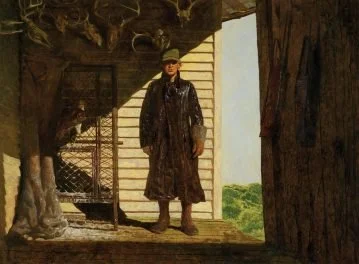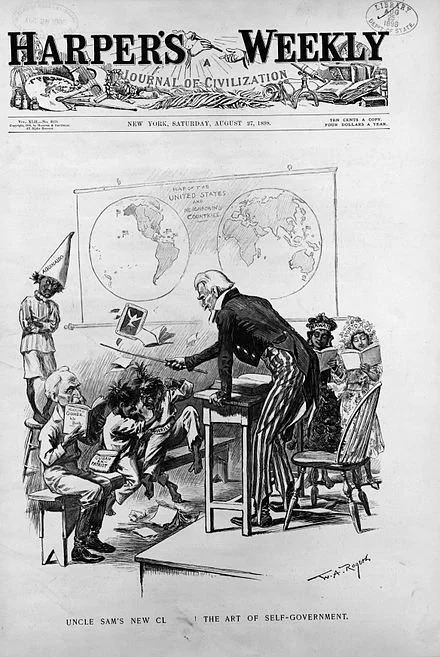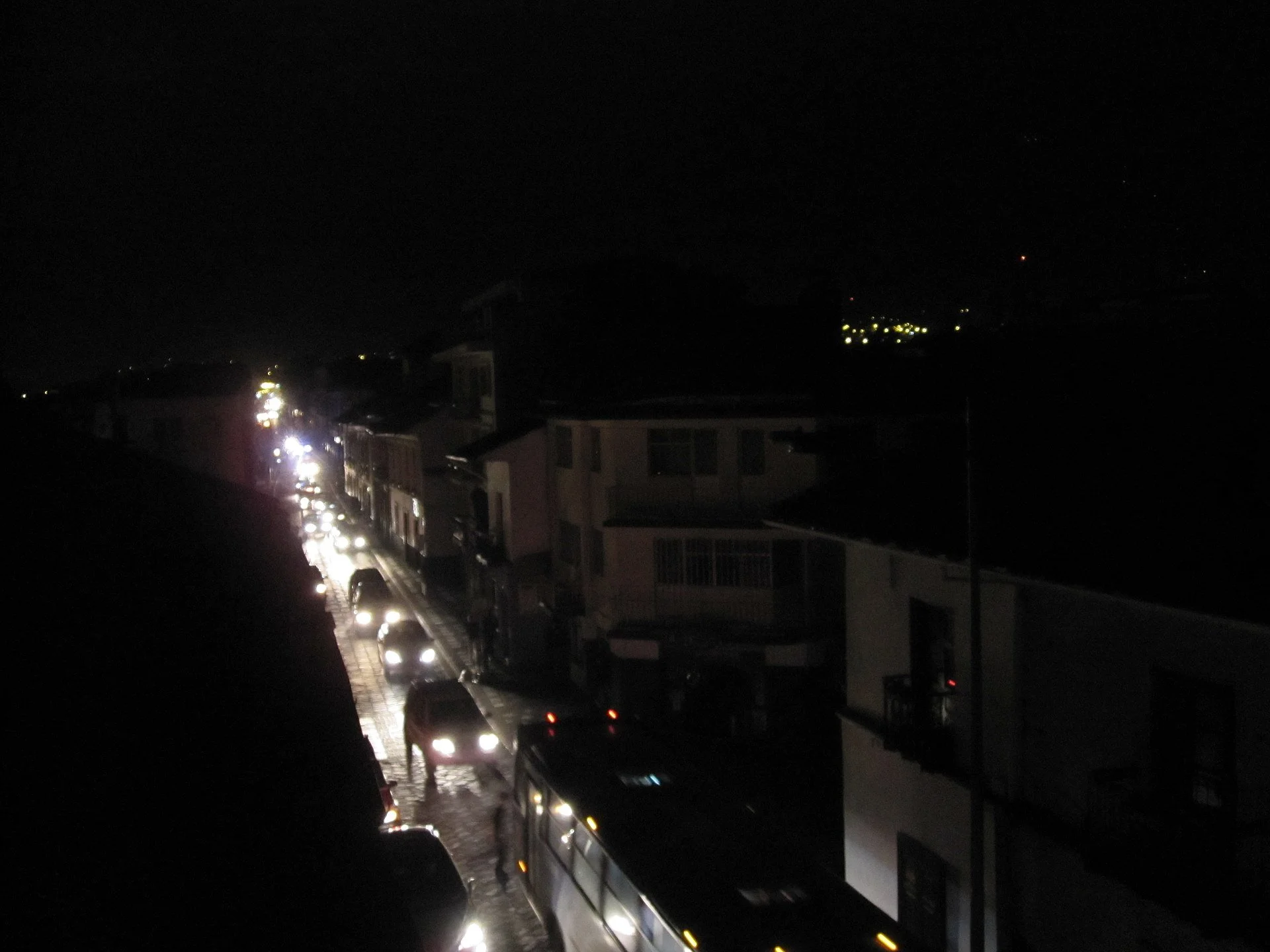In her golden age
“Mom's Prom Dress” (oil on linen), by Tara Lewis, in the show “Hidden Treasures 6, a the Lamont Gallery, at Phillips Exeter Academy, Exeter, N.H.
— Photo courtesy Lamont Gallery
The gallery explains:
The show “highlights the work of Phillips Exeter Academy faculty from across departments. From multi-media to photography to painting and fiber art, 47 artists display their varied work. Aside from the visual arts, this exhibit also highlights music and literary art created by the faculty at Phillips Exeter Academy.’’
Chris Powell: Hartford doesn’t need hockey and state’s ‘values’ don’t help
At the XL Center, in Hartford.
— Photo by Enterprise8875
MANCHESTER, Conn.
Some people think that Hartford's decline began in 1997, when the city's National Hockey League team, the Whalers, left for North Carolina. Gov. Ned Lamont seems to be one of them, though the city's plunge into poverty and dysfunction started at least 30 years earlier.
For a few years in the 1980s and '90s the Whalers did manage to fill some downtown Hartford restaurants and bars on game nights as the team played at the Hartford Civic Center Coliseum. But most Whalers fans were suburbanites who quickly went back home, doing nothing to improve the city's demographics. Even with a National Hockey League team the city kept losing its middle class.
Maybe NHL hockey could help Hartford a little more now since, thanks to a bailout from state government, the city has built a lovely minor-league baseball stadium near the coliseum, renamed the XL Center. With baseball in the warmer months and hockey in the colder ones, and with the housing the city is striving to restore downtown, maybe more middle-class people could be induced to live in the city again.
But hockey is an acquired taste and the governor's enthusiasm for it in Hartford is not supported by history. The Whalers seldom filled their arena and the joke was that each game was like a Grateful Dead concert -- the same several thousand people.
When the other day the governor said his administration is “ready” for the return of big-league hockey to Hartford at the XL Center, with the possible relocation of the Arizona Coyotes, he couldn't have been serious. While state government is appropriating $100 million to renovate the arena, the project already is expected to run $40 million over budget, and a new team's likely demand for government subsidies has not been acknowledged, much less addressed.
Indeed, in 1996, as the Whalers demanded that state government build them a new arena even as they couldn't fill the one they had, the Journal Inquirer calculated that between financial bailouts of the team, discounted and unpaid state loans, and free use of the coliseum, state government was subsidizing the team by $32 per ticket sold, or $1,400 per spectator per season. This shouldn't have been surprising, since the Whalers had only three winning seasons out of 18 in the NHL. (The Coyotes have had only two winning seasons in their last 10.)
How much per ticket will Connecticut have to subsidize another round of NHL hockey in Hartford, and where will the money come from? The remnants of state government's federal emergency money are already being claimed many times over.
Improving Hartford's demographics is a worthy project, but hockey isn't likely to accomplish even a tiny fraction as much as a few new supermarkets would, and subsidizing new supermarkets for a while probably will be necessary to make the city's notorious “food desert” bloom.
Like other Southern states, North Carolina has been enjoying more economic and population growth than Connecticut, but three Democratic state senators here have an idea for reversing the trend.
They note that North Carolina's Republicans have given their nomination for governor to Lt. Gov. Mark Robinson, a nutty Bible thumper, so the Democratic senators -- Senate President Pro Tem Martin M. Looney, Majority Leader Bob Duff, and Deputy Senate President Joan Hartley -- have urged Connecticut's economic development commissioner to appeal to North Carolina businesses to flee their state's impending nuttiness by moving here.
Duff says, "A lot of people come to Connecticut because they like our values."
Unfortunately those "values" lately include government employee union control of public finance, high taxes, high electricity prices, ever-increasing mandates on business, nullification of federal immigration law, racial preferences, abortion of viable fetuses, boys impersonating girls in sports, sex-change therapy for minors, the concealment by schools from parents of the gender dysphoria of their children, pervasive euphemizing, and politics less competitive than Russia's.
Bible thumping may be easier to live with.
Chris Powell has written about Connecticut government and politics for many years (CPowell@cox.net).
Enjoy it before it washes away
“Special ‘‘ (in Barnstable, on Cape Cod), by Bobby Baker
William Morgan: All that and nothing at all; how not to promote a state
The State of Rhode Island, beset by the self-inflicted woes of failing infrastructure, persistent corruption and a lack of self-confidence, has launched a new tourism initiative that it hopes will bring swarms of visitors to our shores this summer. “All That” is the campaign’s motto.
All That, period. What’s more banal than a lighthouse?
—Commerce Rhode Island
Despite its 1990s hip-hop vibe, the pandering of Rhode Island to potential visitors is clothed in familiar banal corporate-speak, accompanied by photographs of lighthouses and Newport mansions, with “All That” splashed across them.
There are videos showing young and happy revelers biking, surfing, dining – creepily identical to the branding firm’s clips on Belize, Park City, and other fun destinations–what you might expect from a Florida agency whose motto is “We make momentum happen’’.
Why does our culturally and geographically endowed Rhode Island need this everywhere -- and — everyone sanitized vision of itself?
Rhode Island is not the only state going through the periodic contortions of trying to sell themselves to mythical, profligate-spending hordes of tourists. Politicians are also easy marks for snake-oil salesmen of new images that they hope will appeal to the electorate.
(“All That”has apparently cost taxpayers half a million dollars, but queries through the Access to Public Records Act will no doubt reveal a much higher figure.)
Political appointments offer clues about the cluelessness of heads of state, so it should come as no surprise that Anika Kirble-Huntley, the chief marketing officer for Rhode Island Commerce, has spent her entire career in the casino industry.
Fun-Sized, perhaps, but what potential tourist would be enchanted by this murky and grim image?
—VisitRhodeIsland.com
“All That” is the fourth tourism re-brand fiasco in recent years. There was the embarrassing “Fun-Sized” campaign, and the slightly mysterious “Whatever you do …” The most infamous, however, was when Rhode Island hired design-great Milton Glaser to come up with the tepid slogan “Cooler and Warmer,” complete with a clip of alleged local skateboarders zipping along the harborside – in Reykjavik. Slightly less egregious was “Discover Beautiful Rhode Island,” whose chief legacy is handsome signs positioned at the state line.
A quiet sign exhorting Rhode Islanders to discover where we live; tourists on I-195 are in a rush to get to Cape Cod.
— Photo by William Morgan
Rhode Island, to which my wife and I moved to by choice twenty-five years ago, may be the smallest state by area, yet it boasts 400 miles of Atlantic shore, a rich 400-year history seen in an incredible array of outstanding architecture. We were enchanted by Rhode Island’s diversity, its food, its educational institutions, and its palpable tradition of independence and tolerance.
Content with Rhode Island, I do not envy any state its bigger size. But, at the other side of the continent, I am in awe of Alaska’s waving identifier. It is an impeccable and unimpeachable symbol, perhaps the best advertisement for any American government entity. There are no mottos, no Latin phrases, no animals, or any potentially controversial figures – just a tribute to the northern sky.
The blue field with the gold stars of the Big Dipper pointing to the North Star, is a simple, strong, and recognizable design that has served boldly for a century, from territory to 49th state. This powerful, no-nonsense banner, adopted in 1927, will look fresh in another hundred years. Part of the brilliance of the design lies in its genesis: the American Legion sponsored a competition among school students throughout the territory that brought forth 700 entries. The winner was Benny Benson, a Native Alaskan orphan. For his brilliant scheme Benson was given a gold watch and $1,000. As “All That” demonstrates, the price of re-branding has gone way up, and handsome civic design is mostly a thing of the past.
The flag of Alaska, designed almost a century ago.
Rhode Island would have been better served by giving the money spent on the advertisements to folks to enable them to host visitors. The people who run the state gravitate to bigger scams, such as pro-sports stadiums, movie studios, and dubious highway contracts. Citizens will never see much of this squandered money again, even though we will be underwriting it for decades. Nevertheless, it is time to stop wasting dollars on silly, meaningless, and dubiously ineffective tourism promotions. Like the Alaska flag, Rhode Island itself ought to be advertisement enough.
William Morgan is an architectural writer based in Providence. His latest book is Academia: Collegiate Gothic Architecture in the United States (Abbeville).
Llewellyn King: Capitalist solutions to the housing crisis
The Royal Mills complex, in West Warwick, R.I., a former textile factory that was converted to 250 residential apartments.
WEST WARWICK, R.I.
The housing crisis, which is spread across the United States, is most easily measured in the human cost. At the low end that is families, working families, forced to go without a roof, to live in cars, on the streets, and in tent cities or municipal shelters.
But there are other costs, mostly to young people; costs like getting married and having to live with parents or living in a group house long past the age when that is an adventure.
A big cost of the housing crisis is labor mobility.
One of the great strengths of the American workforce has been its preparedness to relocate to the work, unlike parts of Europe where the workers have demanded that the work come to them.
It was this mobility that fed the growth of California and today is feeding the growth of Texas, although housing stress — particularly in Austin, the dynamic capital — is beginning to be a problem there.
Mobility is a feature that made America America: its restlessness, its sense of seeking the frontier and moving there.
According to Dowell Myers, a professor of policy, planning and demography at the University of Southern California, whom I recently interviewed on the television program White House Chronicle, 21 percent of the population relocated every year, now it is down to 8 percent.
According to Myers and other experts, the housing shortage has been building since the Great Recession of 2008 to 2009. This has been multifaceted and includes a shortage of money available for lending to builders, labor shortages, supply chain disruptions, but particularly local exclusionary laws.
To my mind, and to architects and developers I have spoken to, those laws are the biggest problem: the mostly smug, leafy suburbs don’t want new townhouses or apartments. That introduces underlying issues of class and race. In the suburbs, two of the most dreaded words are “affordable housing.”
The answer is to build “luxury” housing rather than designated low-income housing, according to Myers. It is a view I have espoused for years. Build upscale housing that caters to the middle class and as people move up, more housing will become available at the bottom. It is capitalism at its simplest: supply and demand at work. At present we have too much demand and not enough supply.
An extraordinary thing about the housing crisis that is crippling the nation and changing its social as well as its labor dynamics, is why isn’t this a prominent issue in this presidential election year.
It is an issue that could bolster candidates because there are things at the federal level which can be done. Here is a problem that affects all. Where are the political solutions coming from the top? Where are the political reporters asking the candidates, “What are you going to do about housing, a here-and-now crisis?”
Public housing comes pre-stigmatized. The answer is the market. It isn’t a free market because it is inhibited by the fortress-suburb mentality, but there is enough room for the market to accelerate, to build more houses with just a little federal incentive.
Some of the most attractive homes in New England are in converted mills and factories. These grand structures have been turned into what realtors call “residences.”
The use of the word residences, instead of apartments, denotes something desirable. So be it: If it works, do it.
Much of the rehabilitation of the industrial properties in New England, and across the country, has gone in tandem with tax incentives. In one case, these were enough for the developers to produce 250 apartments from one historic mill in Rhode Island. (See photo.) Up and down the country there are abandoned industrial properties that require little zoning hassle to be repurposed.
USC’s Myers, who says every kind of housing is needed, points out that building for those who can afford to buy works in another way: It inhibits gentrification and the social upheaval, as the poor are pushed out of their old neighborhoods, something which, by the way, has been very apparent in Washington, D.C.
The use of urban space is changing, shopping centers are failing and office buildings are losing their luster, and that means housing opportunities. Repurposing isn’t the only answer, and a lot of new housing is needed, but there is huge evidence that repurposing works from the factories of New England to the lofts of Manhattan — desirable housing has been created from the debris of the past.
Building anything anywhere isn’t a simple matter, but once the financial incentives are gotten right, things begin to move. It will take decades to fix the housing problem, but that should be accelerated now.
Llewellyn King is executive producer and host of White House Chronicle, on PBS. His email is llewellynking1@gmail.com, and he’s based in Rhode Island.
Happy days
“Boston Public Garden Serenade,’’ by Sudakshina Bhattacharya, in the show “Clean Slate: A Juried Exhibition Inspired by the Change of Season,’’ at StoveFactory Gallery, in Boston’s Charlestown section.
— Photo of painting courtesy of the artist
The gallery says the show “embraces spring through 68 works made by 48 artists who create across all mediums. ‘‘
Arthur Allen: Using a gene test to avoid chemotherapy overdose
A woman with breast cancer receiving chemotherapy.
From Kaiser Family Foundation Health News
One January morning in 2021, Carol Rosen took a standard treatment for metastatic breast cancer. Three gruesome weeks later, she died in excruciating pain from the very drug meant to prolong her life.
Rosen, a 70-year-old retired schoolteacher, passed her final days in anguish, enduring severe diarrhea and nausea and terrible sores in her mouth that kept her from eating, drinking, and, eventually, speaking. Skin peeled off her body. Her kidneys and liver failed. “Your body burns from the inside out,” said Rosen’s daughter, Lindsay Murray, of Andover, Mass.
Rosen was one of more than 275,000 cancer patients in the United States who are infused each year with fluorouracil, known as 5-FU, or, as in Rosen’s case, take a nearly identical drug in pill form called capecitabine. These common types of chemotherapy are no picnic for anyone, but for patients who are deficient in an enzyme that metabolizes the drugs, they can be torturous or deadly.
Those patients essentially overdose because the drugs stay in the body for hours rather than being quickly metabolized and excreted. The drugs kill an estimated 1 in 1,000 patients who take them — hundreds each year — and severely sicken or hospitalize 1 in 50. Doctors can test for the deficiency and get results within a week — and then either switch drugs or lower the dosage if patients have a genetic variant that carries risk.
Yet a recent survey found that only 3% of U.S. oncologists routinely order the tests before dosing patients with 5-FU or capecitabine. That’s because the most widely followed U.S. cancer treatment guidelines — issued by the National Comprehensive Cancer Network — don’t recommend preemptive testing.
The FDA added new warnings about the lethal risks of 5-FU to the drug’s label on March 21 following queries from KFF Health News about its policy. However, it did not require doctors to administer the test before prescribing the chemotherapy.
The agency, whose plan to expand its oversight of laboratory testing was the subject of a House hearing, also March 21, has said it could not endorse the 5-FU toxicity tests because it’s never reviewed them.
But the FDA at present does not review most diagnostic tests, said Daniel Hertz, an associate professor at the University of Michigan College of Pharmacy. For years, with other doctors and pharmacists, he has petitioned the FDA to put a black box warning on the drug’s label urging prescribers to test for the deficiency.
“FDA has responsibility to assure that drugs are used safely and effectively,” he said. The failure to warn, he said, “is an abdication of their responsibility.”
The update is “a small step in the right direction, but not the sea change we need,” he said.
British and European Union drug authorities have recommended the testing since 2020. A small but growing number of U.S. hospital systems, professional groups, and health advocates, including the American Cancer Society, also endorse routine testing. Most U.S. insurers, private and public, will cover the tests, which Medicare reimburses for $175, although tests may cost more depending on how many variants they screen for.
In its latest guidelines on colon cancer, the Cancer Network panel noted that not everyone with a risky gene variant gets sick from the drug, and that lower dosing for patients carrying such a variant could rob them of a cure or remission. Many doctors on the panel, including the University of Colorado oncologist Wells Messersmith, have said they have never witnessed a 5-FU death.
In European hospitals, the practice is to start patients with a half- or quarter-dose of 5-FU if tests show a patient is a poor metabolizer, then raise the dose if the patient responds well to the drug. Advocates for the approach say American oncology leaders are dragging their feet unnecessarily, and harming people in the process.
“I think it’s the intransigence of people sitting on these panels, the mindset of ‘We are oncologists, drugs are our tools, we don’t want to go looking for reasons not to use our tools,’” said Gabriel Brooks, an oncologist and researcher at the Dartmouth {College} Cancer Center, in Lebanon, N.H.
Oncologists are accustomed to chemotherapy’s toxicity and tend to have a “no pain, no gain” attitude, he said. 5-FU has been in use since the 1950s.
Carol Rosen (left) and her daughter, Lindsay Murray, celebrate Thanksgiving in 2020. Rosen, a 70-year-old retired schoolteacher, passed her final days in anguish, after three weeks of chemotherapy with incompatible drugs.
Yet “anybody who’s had a patient die like this will want to test everyone,” said Robert Diasio of the Mayo Clinic, who helped carry out major studies of the genetic deficiency in 1988.
Oncologists often deploy genetic tests to match tumors in cancer patients with the expensive drugs used to shrink them. But the same can’t always be said for gene tests aimed at improving safety, said Mark Fleury, policy director at the American Cancer Society’s Cancer Action Network.
When a test can show whether a new drug is appropriate, “there are a lot more forces aligned to ensure that testing is done,” he said. “The same stakeholders and forces are not involved” with a generic like 5-FU, first approved in 1962, and costing roughly $17 for a month’s treatment.
Oncology is not the only area in medicine in which scientific advances, many of them taxpayer-funded, lag in implementation. For instance, few cardiologists test patients before they go on Plavix, a brand name for the anti-blood-clotting agent clopidogrel, although it doesn’t prevent blood clots as it’s supposed to in a quarter of the 4 million Americans prescribed it each year. In 2021, the state of Hawaii won an $834 million judgment from drugmakers it accused of falsely advertising the drug as safe and effective for Native Hawaiians, more than half of whom lack the main enzyme to process clopidogrel.
The fluoropyrimidine enzyme deficiency numbers are smaller — and people with the deficiency aren’t at severe risk if they use topical cream forms of the drug for skin cancers. Yet even a single miserable, medically caused death was meaningful to the Dana-Farber Cancer Institute, where Carol Rosen was among more than 1,000 patients treated with fluoropyrimidine in 2021.
Her daughter was grief-stricken and furious after Rosen’s death. “I wanted to sue the hospital. I wanted to sue the oncologist,” Murray said. “But I realized that wasn’t what my mom would want.”
Instead, she wrote Dana-Farber’s chief quality officer, Joe Jacobson, urging routine testing. He responded the same day, and the hospital quickly adopted a testing system that now covers more than 90% of prospective fluoropyrimidine patients. About 50 patients with risky variants were detected in the first 10 months, Jacobson said.
Dana-Farber uses a Mayo Clinic test that searches for eight potentially dangerous variants of the relevant gene. Veterans Affairs hospitals use a 11-variant test, while most others check for only four variants.
Different Tests May Be Needed for Different Ancestries
The more variants a test screens for, the better the chance of finding rarer gene forms in ethnically diverse populations. For example, different variants are responsible for the worst deficiencies in people of African and European ancestry, respectively. There are tests that scan for hundreds of variants that might slow metabolism of the drug, but they take longer and cost more.
These are bitter facts for Scott Kapoor, a Toronto-area emergency room physician whose brother, Anil Kapoor, died in February 2023 of 5-FU poisoning.
Anil Kapoor was a well-known urologist and surgeon, an outgoing speaker, researcher, clinician and irreverent friend whose funeral drew hundreds. His death at age 58, only weeks after he was diagnosed with stage 4 colon cancer, stunned and infuriated his family.
In Ontario, where Kapoor was treated, the health system had just begun testing for four gene variants discovered in studies of mostly European populations. Anil Kapoor and his siblings, the Canadian-born children of Indian immigrants, carry a gene form that’s apparently associated with South Asian ancestry.
Scott Kapoor supports broader testing for the defect — only about half of Toronto’s inhabitants are of European descent — and argues that an antidote to fluoropyrimidine poisoning, approved by the FDA in 2015, should be on hand. However, it works only for a few days after ingestion of the drug and definitive symptoms often take longer to emerge.
Most importantly, he said, patients must be aware of the risk. “You tell them, ‘I am going to give you a drug with a 1 in 1,000 chance of killing you. You can take this test. Most patients would be, ‘I want to get that test and I’ll pay for it,’ or they’d just say, ‘Cut the dose in half.’”
Alan Venook, the University of California-San Francisco oncologist who co-chairs the National Comprehensive Cancer Network, has led resistance to mandatory testing because the answers provided by the test, in his view, are often murky and could lead to undertreatment.
“If one patient is not cured, then you giveth and you taketh away,” he said. “Maybe you took it away by not giving adequate treatment.”
Instead of testing and potentially cutting a first dose of curative therapy, “I err on the latter, acknowledging they will get sick,” he said. About 25 years ago, one of his patients died of 5-FU toxicity and “I regret that dearly,” he said. “But unhelpful information may lead us in the wrong direction.”
In September, seven months after his brother’s death, Kapoor was boarding a cruise ship on the Tyrrhenian Sea near Rome when he happened to meet a woman whose husband, Atlanta Municipal Judge Gary Markwell, had died the year before after taking a single 5-FU dose at age 77.
“I was like … that’s exactly what happened to my brother.”
Murray senses momentum toward mandatory testing. In 2022, the Oregon Health & Science University paid $1 million to settle a suit after an overdose death.
“What’s going to break that barrier is the lawsuits, and the big institutions like Dana-Farber who are implementing programs and seeing them succeed,” she said. “I think providers are going to feel kind of bullied into a corner. They’re going to continue to hear from families and they are going to have to do something about it.”
Arthur Allen is a Kaiser Family Foundation Health News reporter.
ArthurA@kff.org, @ArthurAllen202
Drawing him in
“Forest-Way” (oil on canvas), by Vincent Van Gogh ((1853-1890)
“Many paths in the woods have chosen
me, many a time,
and I wonder often what this
choosing is….’’
‘‘From “Lost,’’ by Hayden Carruth (1921-2008), American poet and editor. He lived in Johnson, Vt., for many years.
William T. Hall: Surviving the swarm
Text and watercolor painting by William T. Hall, a Florida-and-New England-based painter and writer
As we endured one of our family weeding sessions in our vegetable garden in Thetford, Vt., my grandfather said abruptly, and with strong emphasis, the four-letter “S-word”. It was enough of a surprise to lead grandmother to remind him that children were present. “Jesus, Mary and Joseph, Harold, your language – please!”
We all stared at Gramps as Grandmother looked over her glasses at my mother, who was smiling at her while fighting with a deep-set weed. Mother’s garden glove was full of a dozen or so vanquished weed specimens dropping dust as she looked over to me, rolling her eyes. I could see my reflection in her sunglasses as my little brother, Steve, leaned in and whispered to me , while wagging his index finger at the ground, “Naughty-naughty, Gramps”
“What’s wrong, Dad?” my mother asked. “You okay?”, she asked, as she pulled on another stubborn weed.
He said nothing as he set his jaw and unfolded his tall frame upward from his kneeling position like a camel standing up in the desert. He was looking at the top of his wrist as if to check a watch that wasn’t there. In that hand he held a big red Folger’s coffee can half-filled with kerosene into which he had been dropping hundreds of Japanese Beetles. These he had picked meticulously from the leaves of his potato plants. This sort of thing defined one of his methods for guarding against pests in the modern age of pesticides. “Better to pick’m off and get’m before they get you.”
After he had stood up fully, he looked perplexed, as if he didn’t believe what had just happened. He looked at my grandmother and said one word,
“Bee.”
“Sting?“ My mother asked.
“No he just scratched me a — warning”.
This we all knew from being on the farm. When you work around bees they are busy, too, gathering honey. Unless you create too much commotion around bees or otherwise make them too anxious, a human usually gets a (warning) a scratch before a (sting).
A warning was when a bee dragged his stinger across your skin to give you what felt like a little hot spark. A full “sting” was, of course, much more painful and was delivered with a bee’s ultimate strength, resulting in the hooked end of the stinger deep under the skin with the bee’s abdomen still attached to feed the stinger with venom. This added to your pain immensely. For this one extreme act, the honeybee pays with its life, and for allergic recipients, the sting can cause anaphylactic shock. To that person multiple stings all at once could cause death.
To my grandfather this “scratch” seemed like an unprovoked over-reaction, and he didn’t understand what he had done to deserve it.
Harold had been stung several times in his life but he understood that each time he’d done something provocative. When he saw that there were lots of other bees around us not harming us, it seemed as if nothing menacing had happened, so what was the big deal? Grandpa was insulted. He shook his head. My mother, teasing her father, asked him, “Dad, did you make a mistake? You know the difference between a Japanese beetle and a bee right”?
We all laughed and looked at my grandfather, wanting to gauge his reaction to my mother’s tease. He held the coffee can in one hand and laughed politely at the ribbing. He was always a good sport.
“I’m glad I didn’t sit on him”, he said and got a double-good laugh from all of us.
But as he was looking at us he was still wondering why there seemed to be so many bees everywhere in the air. They swirled like embers from a campfire. It was a busy confusion in orange, black and tan reminding him of when he attended his mother’s beehives at their turkey farm in Walpole, Mass., years before.
“Gramps! What’s is that?” asked my brother Steve he excitedly pointed to the sky above and behind Gramp’s silhouetted upper torso.
“Harold!” My grandmother shouted sharply, my grandfather and the sky above him reflecting in her glasses.…
Gramps looked at her perplexed as he turned to see what she meant. Something amazing and frightening was happening in the sky behind him. He had never seen anything like it before, and nor would he ever again. He looked back in awe at a jet-black roiling cloud in the sky over the Connecticut River. “It’s bees!”Then suddenly,“ SWARM!” he yelled as he set down his coffee can.
“What the heck!?” My mother exclaimed as she stood up, dropping her spade and the weeds from her gloves.
“Gloria, Quick help me up!” my grandmother yelled. My mother said frantically, in a commanding voice, to Steve and me, “Kids, get your grandmother up and head to the house”! As we helped our 200-pound grandmother to her feet, our mother rushed to her father’s side asking. “What should we do? Dad?”
They both looked up at the cloud and now we all could hear the sound of the bees, which mimicked the sound of a breeze blowing through tree leaves.
My grandfather mumbled something unintelligible in Swedish under his breath.
“Pop, in English!”, my mother asked in a slightly panicked tone. “What should we do?”
Without taking his eyes off the swarm, Gramp said, “Yes, get Lillian to the house, but don’t run, Ok? Just walk fast and don’t panic. We must not spook the swarm. Look at them! They look pretty riled alread.”
“Harold, you be careful,’’ my grandmother said.
“We’ll be fine, ’’ he said.
“Somewhere in the middle of the swirling mass is the Queen. Bees will do anything to protect their Queen. They’re looking for a new hive. These other bees down here are the scouts”.
Our farm was on the floor of Vermont’s Upper Connecticut River Valley about a football field’s length from the river and a mile’s south of the village center of Thetford. Our barn was in the middle of our property between two 25-acre fields, with two big shade-maple trees taller than any other trees next to the barn, which was four stories tall, from the basement to the peak of the open hayloft.
The whole barn structure was basically open. It was June, and the barn was empty of hay. There was one window in the peak and an open hay door in the end. The barn was designed to suck air in at the basement pig stalls on the backside of the building and to direct it inward and upward out through the big open barn doors and hay doors in both peaks. Those doors were 16 feet tall and were at the top of the earthen ramp that led to the second story. The ramp was designed for horses pulling full hay-wagons up into the big main hay-storage room. The main room was enormous, about 40 by 60 feet and 45 feet to the peak, where the hay trolley track and unloading-fork still hung covered in cobwebs.
Grandpa knew that the swarm of bees high in the air above our barn probably saw what looked like the perfect place for new beehive — a place with the perfect size and shape to house what seemed like a zillion tired and desperate bees and their queen.
My grandfather could see this in the few moments he had to scope out the problem and he understood that the welcome mat would be out until he could close up the barn to keep out these unwelcome guests.
Gramps now could hear the house windows being slammed down shut and the garage door being closed in the long shed off the main house. The ladies had done their job. The house would be a secure hiding place for the family no matter what happened in the other buildings. Grandpa’s carpentry shop, the hen house, a little stone milk-house and our barn were the only possible manmade homes for the bees.
The area directly above and behind the barn was a jet-black fuzzy moving mass. The swarm covered the whole width of the house, barn and shade trees. The scene reminded Gramps of the sand-and-soil clouds during the 1930’s Dust Bowl. Like those roiling clouds, the cloud of bees had a dark and menacing look.
Like a monster in the sky, the cloud seemed to lurch forward, north up the river, and then roll back on itself down the river as if there was dissension in the cloud of bees.
The air around us was still filled by a blizzard of bees, but even though we were occasionally scratched by the frantic scouting insects, we did not feel in danger. We could see their dilemma. We did not want to make their plight any worse than it was, but they could not have our barn, from which it would have taken months and lots of money to dislodge them. Worse, many bees would die in the removal. Maybe the bees could feel this, or maybe they were totally unaware of us, but they continued to leave us alone.
Gramps knew that with any flood of living things — humans, cattle, turkeys, fish and so on, only so many of them could get through a restricted opening at once without catastrophic results.
They had only their instinct to protect and nurture their queen. Each individual bee was devoted to its queen first, then secondly to the whole hive. Beyond that simple reality they had not evolved.
They were incapable of leaving her but confused about where to take her. At this point they seemed at a crossroads.
“Billy, go to the basement of the barn and close all the pig-pen doors down there,’’ Gramps told me. “Make sure the bees can’t get through any cracks. Throw hay at the bottom of the doors to close up the gap. Then meet me at the front ramp and we’ll close the big doors together. We can get to the windows last. Listen to me.…If this all turns bad, then get to the house and your mother will know what to do”.
“Where are you going, “ I asked.
“I’ll go to my shop and see if I can close it up. It’s wide open”.
“What about the chickens,” I asked.
“I don’t know? They eat bugs. They’ll have to fend for themselves”.
The cloud of bees was hanging over the rear pasture and getting closer to the barn by the minute, casting a dull shadow as when a cloud causes a shadow in the valley. I did get stung when I closed the last pig-pen door and I put my hand right on a bee. It hurt, but I sucked on the spot and kept moving.
When I got to the big doors in the front of the barn, grandfather was there. He’d rolled the burn-barrel up the ramp, saying that would be a last resort. He would start a smudge fire in the barrel to smoke out the incoming bees if it became necessary. The thought of any open fire in our barn made us both sick to think about. “Would you really risk that”, I asked my grandfather.
“No. I don’t think so, but we’ll see”.
As we rolled the barrel into place, something in the changing sky caused a shift on what had been sun-lit ground to scattered shadows there. With that change came a slight drop in temperature.
The moment seemed to signal something within the swarm. The bees moved. They roiled northward, and then suddenly their pace increased and they seemed to rise up farther. There was a bulge in the front of the cloud as it headed up river. The swarm passed over the iron bridge a half mile away at East Thetford and continued headed north, up the river. Where there had been millions of scouting bees at our farm, in a few minutes there were none.
The swarm eventually disappeared into far northwestern New Hampshire, where they were believed to have taken up residence in the stacked-up wrecked automobiles in a large junkyard abandoned years before, and then, finally, in spectacular Franconia Notch.
Little by little, one of those companies that catches and ships bees were able to capture many of the insects and transport them to areas of the U.S. that suffered from a deadly fungus that still endangers bee populations today.
Where the bees came from in such large numbers and why they took flight has never really been determined.
A history of loafers (shoes)
Note that these were made in El Salvador!
The G. H. Bass & Co. shoe factory, in Wilton, Maine; from a 1914 postcard. Built on Wilton Stream in 1904 and known as No. 1, the factory closed in 1998. The factory made the famous Bass Weejun loafers.
Excerpted from a New England Historical Society article
“The penny loafer may epitomize preppy New England style — after all, John F. Kennedy wore penny loafers on the golf course. And John Cheever, chronicler of New England preppy angst, was known for his wrinkled khakis, blue-and-white striped Brooks Brothers shirt and Size 6 penny loafers.
“But the penny loafer didn’t originate in New England.
“Nonetheless, New England played an important role in the development of the penny loafer, in large part because of its long shoemaking tradition.
“The region’s indigenous people made moccasins by hand for centuries. They also provided the design inspiration for the penny loafer (more about that in a bit). Nine years after the Pilgrims landed, a cordwainer arrived to make shoes for the colonists.’’
Stuck on the seas
“The Flying Dutchman,’’ by James Cole, in his show at Galatea Fine Art, Boston, through March 30.
'At home with uneasy subjects'
“Bean Boots’’ (oil on panel), by Jamie Wyeth, in his show “Unsettled,’’ at the Farnsworth Art Museum, Rockland, Maine, July 4-Sept. 29.
The museum says:
“This exhibition traces a persistent vein of intriguing, often disconcerting imagery over the career of renowned artist Jamie Wyeth (born 1946). Frequently countered and even hidden by Wyeth’s fuller body of work—particularly his well-known coastal views and farmscapes—the darker and more troubling imagery is constant throughout his oeuvre. Whether he is introducing curious characters or surveying strange landscapes, Wyeth is at home with uneasy subjects and a master of the unsettled mood.’’
Offices to mini-factories
The empty Industrial Trust Building in Providence.
Downtown Boston in June 2017
— Photo by AbhiSuryawanshi
Adapted from Robert Whitcomb’s “Digital Diary,’’ in GoLocal24.com
Proposals to fill up a lot of those post-pandemic and still partly empty downtown office buildings in Providence, Boston and other cities have usually focused on converting them to housing. But given their features, especially their large floor plates, high ceilings, utility layouts and huge windows, turning them into places for light assembly of high-tech and other physical products makes more sense. Something like this has been underway in the past few years in Boston and Cambridge as biotech companies have moved labs into some space previously used for offices for “white-collar” workers.
Call them mini-factories. We often forget that many Northeast city downtowns once had substantial manufacturing operations, including, up until around 50 years ago, some heavy manufacturing. Reinvigorating downtown manufacturing would help create more diverse and thus healthier urban economies. It’s clear that in this age of remote work, many office workers won’t ever return to downtown office towers.
We must focus on building much more housing. Trying to transform office buildings into dwellings won’t help much.
Spring in New England? Eh?
“Spring,’’ by Maxfield Parrish (1870-1960), for the cover of Life magazine’s Easter 1922 edition. Parrish was a member of the famous Cornish Art Colony in and around Cornish, N.H.
Chris Powell: More discipline would mean less racism in schools
Harper's Weekly cover from 1898 shows a caricature of school discipline.
MANCHESTER, Conn.
Cromwell, Conn., lately has been convulsing over a student's at-first anonymous public complaints about racist or abusive conduct by other students in school.
What was the first action taken in response by the school administration and the town's Board of Education? Of course it was to hire a consultant -- an expert in "diversity, equity, and inclusion."
Cromwell's school officials may have been surprised to discover that children can be bratty and even vicious quite apart from anything related to "diversity, equity, and inclusion." Any personal characteristics can be targeted by childish brattiness and viciousness. Race is just one of many such opportunities.
Nobody who has spent time with children needs a "diversity, equity, and inclusion" consultant to know that. But such a consultant will just help school officials look sincere.
If school officials were ever really sincere about misbehavior by students, instead of hiring a consultant they might make it a practice to have every student interviewed confidentially every month by a teacher, administrator, or guidance counselor and asked about any problems they were having in school. At these interviews students would be instructed in or reminded of the necessity of decent behavior and the penalties for misconduct.
Each meeting would be summarized in writing by the interviewer and the student would be invited to add his own comment before both acknowledged the summary in writing and the summary was placed in the student's file. Specific complaints by a student would be promptly investigated. Due process would be provided and formal judgment issued, and upon any finding of misconduct, punishment imposed on the perpetrator.
Schools in Connecticut have a miserable reputation on their response to bullying, perhaps because discipline in school has become politically incorrect, which may be the precursor to much of the racism and misconduct being complained about lately.
But the problem of bratty and vicious kids and ineffective school administration is an old one, and the General Assembly may be even more oblivious to it than Cromwell seems to be.
After testimony from parents, teachers, psychiatrists, and others about hateful conduct among school children, the legislature's Committee on Children recently proposed legislation to appoint a "task force" to study it. Apparently the need for more discipline in school has not occurred to the committee.
Some Democratic legislators have soared beyond obliviousness on the issue. They have proposed legislation to prohibit colleges and universities from questioning applicants about any criminal records and discipline for misconduct in high school. That's the Democratic Party's approach to crime generally these days: to conceal it in support of claims that crime is down as society disintegrates.
One hardly needs to consult an expert in "diversity, equity, and inclusion" to figure out what will happen when word reaches high school students about the law forbidding colleges and universities from questioning applicants about their misconduct. Misconduct will be liberated.
It's still early in the legislative session and craziness like the college legislation may be weeded out. But given the legislature's far-left Democratic majority, it's just as likely that the college legislation will be amended to impose fines and prison time on any admissions officer who asks an applicant if he has murdered anyone lately.
MORE HIDDEN FEES: Connecticut Gov. Ned Lamont has a great idea. He wants the General Assembly to pass legislation to prohibit hidden fees on event tickets, hotel and short-term rental bills, and food and beverage sale and delivery services, "fees that are tacked on at the end of a consumer's transaction."
But why stop there? For the biggest perpetrator of hidden fees in Connecticut is state government itself.
It's not just the "public benefits" charges concealed in electricity bills -- transferring to paying customers the cost of electricity used by customers who don't pay, along with charges for government undertakings irrelevant to electrical generation.
It's also the wholesale tax imposed on fuels and the cost of state mandates on medical insurance, health care, and municipal government, costs passed along discreetly to customers and taxpayers.
Concert tickets are the least of the scam.
Chris Powell has written about Connecticut government and politics for many years (CPowell@cox.net).
Llewellyn King: Going dark? Crisis building in the U.S. electricity system
— Photo by Jen
WEST WARWICK, R.I.
There is a gathering storm over the nation's electric supply.
What has been described as the world’s biggest machine, the U.S. electricity system, is stressed — and that stress will increasingly affect reliability. That means sporadic blackouts, some extensive. While the nation won’t be plunged into total darkness, there will be regional difficulties, according to the industry’s own watchdog group, the North American Electric Reliability Corporation.
There are nearly 3,000 electric utilities in the United States and what is known as the grid is, in fact, three grids: the Eastern, the Western and Texas. The first two interconnect and flow power back and forth where possible, but Texas is separate — and not subject to the regulation by the Federal Energy Regulatory Commission.
There are three classifications of electric utilities: the big investor-owned companies such as Pacific Gas & Electric, ConEd, and the operating units of the giant Southern Co.; the 2,000 public power companies, usually municipally owned and a few, such as the Tennessee Valley Authority, federal government-owned, and the rural electric cooperatives, which can be quite large or very small. Together they operate the grids in surprising harmony and collegial cooperation.
The price of electricity is rising faster than general inflation, according to the Energy Information Administration — a sure sign of building pressure on the companies.
The causes of this stress are many. First, there is more demand for electricity across the board. That demand is rising at about 2 percent a year and the rate of increase may accelerate after 2026.
Contributing to the demand is the proliferation of data centers and their huge appetite for electricity – an appetite now fed by artificial intelligence and its increasing use everywhere.
Then there is the impact of environmentally driven demand: switching heavy industry from using fossil fuels to using electricity for high-energy uses like steel-making. This is set to grow.
In the same way, the use of electrified transportation is upping its share of electricity demand: It isn’t just Priuses and similar personal vehicles but big fleets, particularly for in-city deliveries. The U.S. Postal Service, Amazon and other fleet users are converting to electricity. Burns & McDonnell, the Kansas City, Mo.-based engineering, architecture, construction, environmental and consulting solutions firm, estimates half of intracity deliveries will be with electric vehicles by the end of the decade.
Increasingly, new homes will be all-electric — this as the future of natural-gas supplies is compromised by public policy.
Exacerbating instability in the electric sector has been the swing from fossil fuel generation — primarily coal and natural gas — to renewables. Those simply aren’t always available. The race is on for better batteries and storage of all kinds to smooth out the variability of wind and solar, especially wind.
Nonetheless, the pressure is constant to close coal and gas plants, which have always available generation, known in utility parlance as “dispatchable,” and account for 19 percent and 38 percent of generation respectively. It adds to the difficulties in keeping the lights on.
The dilemma was set out for me by Duane Highley, CEO of Tri-
State Generation & Transmission, based in Westminster, Colo. It provides power to 42 rural co-ops in four states.
Highley explained the new instability in industry like this, “The rapid rate of retirement of dispatchable generators has raised concerns among our membership about the reliability of the greater grid.”
He said that the industry can and is achieving rapid rates of emissions reduction but will still need “an appropriate amount of cost-effective dispatchable generation.”
Today, Highley said, this is provided by coal and natural gas. And this power will be needed to ensure a reliable and resilient grid as the demand for electricity increases.
“The traditional metrics utilities have used to model reliability can no longer demonstrate grid resilience as we rely more on intermittent weather-dependent resources.”
Tri-State, Highley said, is “working with its members on new reliability methodology to assure we have sufficient capacity, even with high levels of renewable generation.”
Electricity loss is a lethal matter.
In Texas 254 people, by official count, died when some of the grid went down during the blackout, caused by Ice Storm Uri, in 2021. And in last year’s heat dome over Arizona, the state estimates 654 people died from heat-related causes in Maricopa County alone.
Clearly, job one is to keep the lights on before we retire the tried-and-true generating plant of yesterday. Life depends on it.
Llewellyn King is executive producer and host of White House Chronicle, on PBS. His email is llewellynking1@gmail.com and he’s based in Rhode Island.
Ukrainian modern art and national identity
“The Caucuses (Geryusi)’’ (1915) (oil on canvas), by Oleksandr Bohomazov, in the show “The Juncture: Ukrainian Artists in Search of Modernity and Identity,’’ at the Mead Art Museum, at Amherst (Mass.) College, May 24-Oct. 13.
— Image courtesy of James Butterwick Gallery, London.
The museum says:
“This exhibition showcases the work of three leading modern artists from Ukraine who produced work during an astonishing period of the country’s cultural renaissance in the early 20th Century: Alexander Archipenko (1887–1964), Oleksandr Bohomazov (1880–1930), and Vasyl Yermilov (1894–1968). Modern and cosmopolitan by nature, their art also addresses the issues of national cultural identity at a time when their compatriots were trying to establish an independent Ukrainian state. The strikingly different fates of the three artists demonstrate the tectonic shifts and upheavals that their country underwent in the first half of the twentieth century. Their work—connected with Cubism, Futurism, Abstractionism, and Constructivism—reflects the stylistic diversity of the avant-garde landscape in Ukraine at that time. ‘‘
We’re mostly water anyway
“Three Graces” (cyanotypes), by Newmarket, N.H.-based David Hiley in the group photography show “Diverse Visions,’’ at Bromfield Gallery, Boston, April 3-28.
Grief support for when pets are dying via UNE
The University of New England’s Biddeford, Maine, campus.
Edited from a New England Council report
The University of New England has announced a new initiative in its online curriculum to include certification for students to work as end-of-life pet doulas. Pet doulas are non-medical-care providers who form companionships with pets, their human families, and veterinarians to guide all concerned through the pets’ dying process.
The fully online program is six weeks long and designed to provide students with expertise in advanced pet-care planning, grief support and emotional guidance. The course is open to participants from all backgrounds and will run from April 1 to May 12.
“It is important to acknowledge the loss people experience when their pet dies and give them the space for emotional expression and validation,” said Tracey Walker, the course instructor, “The more we can work to normalize talking about pet loss, death overall, and the deeply personal journey of grieving, the better we will be equipped to support each other when we need it most.”










































